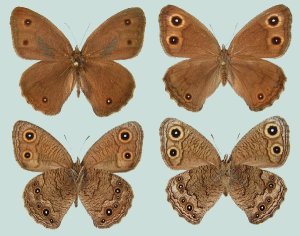Cercyonis sthenele masoni

Photo Life History: Cercyonis sthenele masoni
Habitat: Mountain Canyons (Oak belt)
Host Plants: Bunch grasses
Suitable Lab Host Plants: Bromus inermus; Phalaris arundinacea. (Larvae will accept most grasses in the lab; including lawn grasses.)
How to Find Female Butterflies: Click here. Females tend to be more common two to four weeks after the males emerge and can be found around scrub oaks or along mountain sides.
Caring for Live Female Butterflies: Nectaring techniques
Methods of Female Oviposition: Open Screen Cages; Portable Cages; Potted Plant Sleeves. (Like other Ceryconis spp., females prefer to oviposit on dead grass blades.)
How to Find Eggs:
How to Hatch Eggs: Consolidate eggs into one container. (Eggs take as long as 17 days to hatch in the lab.)
How to Find Caterpillars in the Field:
How to Find Pupae in the Field:
Caterpillar setups: For all Cercyonis, I recommend a unique combination approach that is tedious on the front end, but much easier on the back end. For first instars, place newly hatched larvae on very fresh grass blades in a Closed Container. Like Speyeria unfed first instars, I recommend exposing these larvae to 24 hours of light. Replace host grasses every 24 hours. Sometimes it takes a few days to force these larvae out of diapause. For second instar larvae, I recommend using the Twin Cup Method. Replace frass and host every two to three days. (Host grass keep longer because they are in water.) Once first instar larvae start feeding, it is no longer necessary to expose larvae to 24 hours of light. For third through fifth instar caterpillars, I recommend using the Potted Plant technique. Cercyonis larvae feed just fine on lawn grasses. Here in Utah, there are some wheat grasses that actually send up new growth in the fall. I will dig up and pot those grasses; rotating them about every four to six weeks as I place them in a window sill and watch the larvae grow.
Larva to Pupa: Caterpillar silks to leaf or twig; creates and attaches cremaster; hanging as a J before pupating.
Number of Broods per Year: 1
Overwintering Stage: Unfed first instar.
Overwintering Strategies: Alpine Overwintering Technique; Refrigerator. (Larvae dissicate easily. They need constant humidity and airflow.)
Post-Hibernation Strategies: Healthy Host Plant; Expose larvae to 24 hours of light;
Emergence: Emergence Container
Avoiding Diapause Techniques: Healthy Host Plant; Expose larvae to 24 hours of light. (See caterpillar setups)
Disease Prevention: First Instars: Change out host plant and remove frass every day. Second Instars: Change out host plant and remove frass every two to three days. Third through Fifth Instars: Not needed.
Emergence: Emergence Container
Field Notes: Use a similar rearing strategy for Cercyonis pegala, Cercyonis sthenele, Cercyonis meadi, and Cercyonis oetus. Set up live females in a small cage. Females seem to prefer to oviposit on dead blades of any bunch grass; including Poa pratensis. In the lab, ova postpone hatching for roughly 17 days and unfed first instar larvae diapause. This is oddly similar strategy as compared to Speyeria spp. Larvae can be forced out of diapause by placing them on fresh grass blades and placing them under 24 hours of light. Once larvae start feeding, it is advisable to then rear them through the fall/winter months on any convenient species of potted grass.

